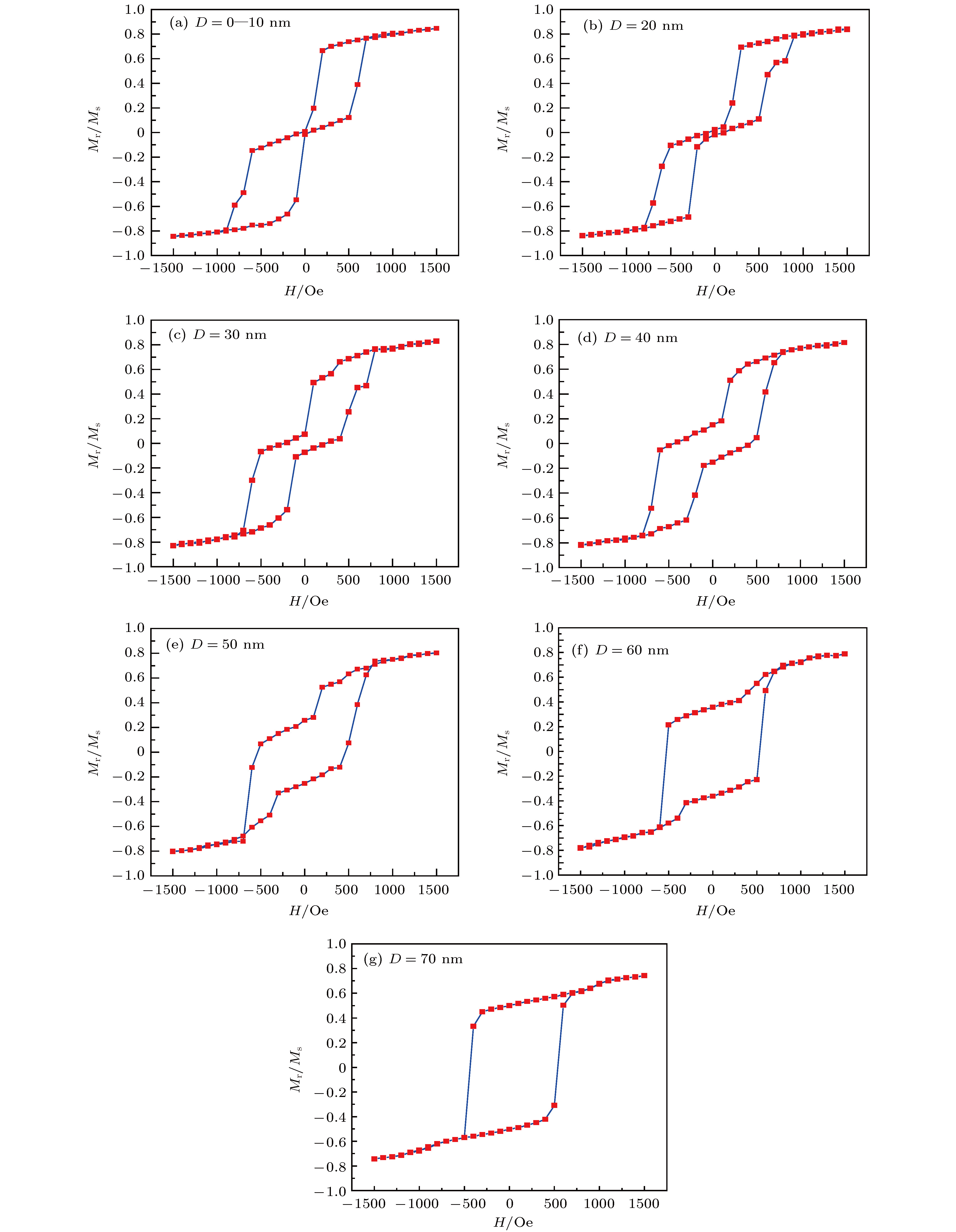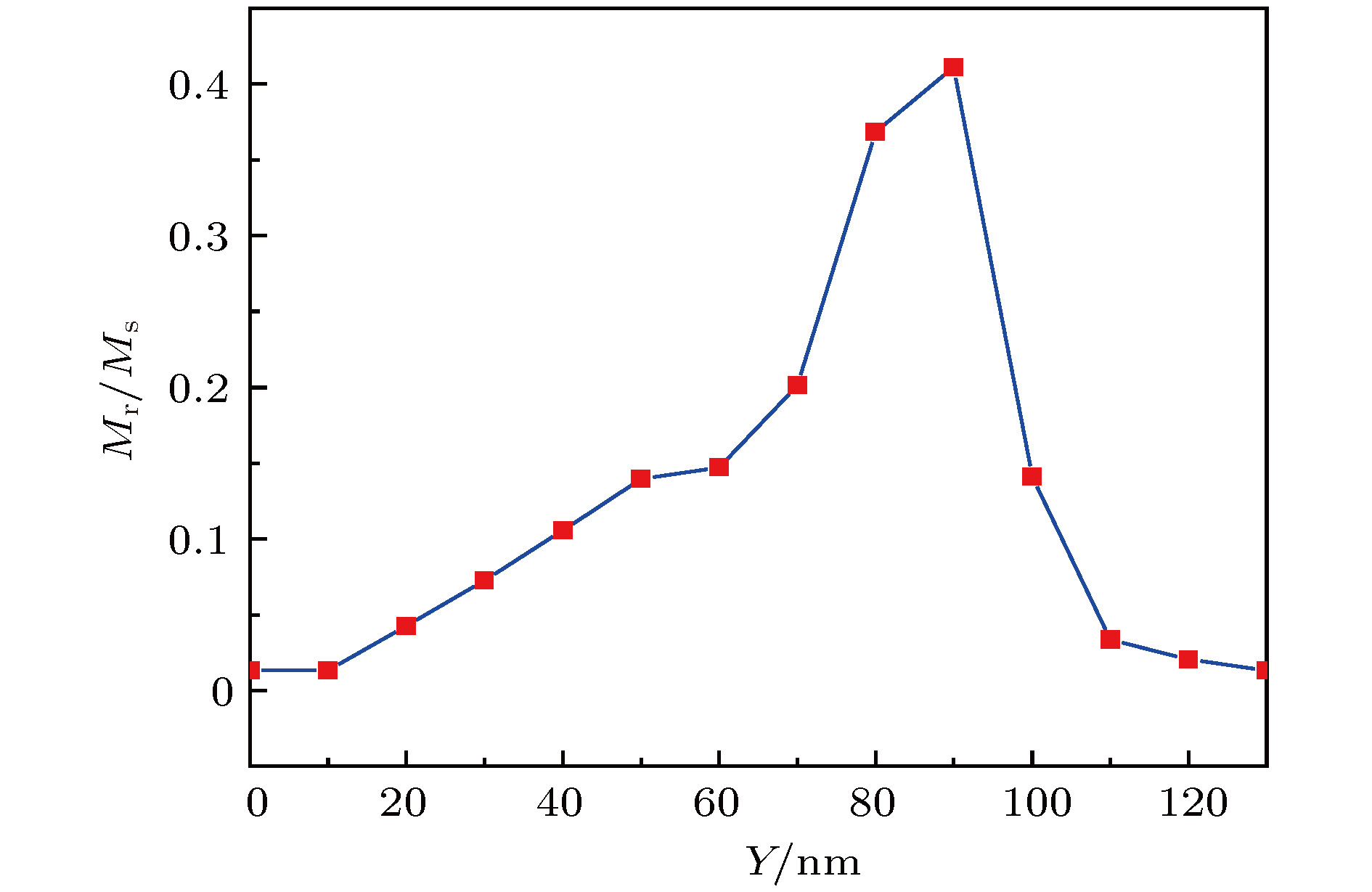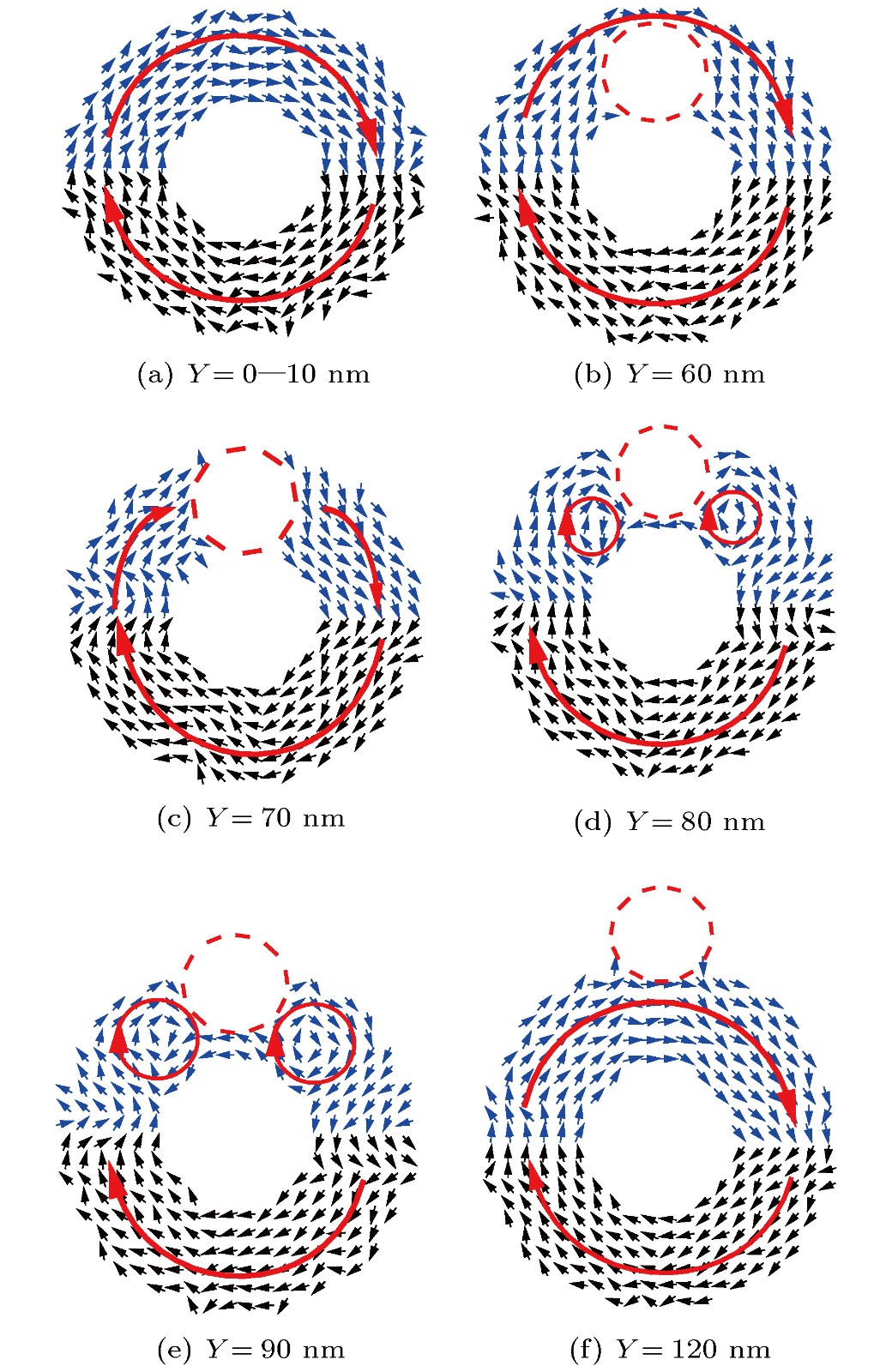-
采用Monte Carlo方法与快速傅里叶变换微磁学方法相结合的方式, 模拟含不同缺陷的铁纳米环的磁滞回线、组态、剩磁等磁特性. 研究发现: 缺陷的大小与位置明显影响系统的磁化过程. 当缺陷较小时, 系统存在双稳态特征, 此性质与无缺陷系统类似; 当缺陷增大时, 系统过渡状态增加, 双稳态特征不再明显. 进一步的研究发现, 缺陷系统的剩磁随缺陷半径D的增大而增大. 上述结果与非对称纳米环系统的磁特性类似, 并可以通过零场状态下的系统自旋组态的变化加以解释. 当系统圆心与缺陷中心的间距Y增加时, 剩磁与Y的关系是非线性的: 剩磁先随Y的增大而增大, 后随Y的增大而减小. 模拟结果可用零场状态下不同Y值的组态变化进行详细解释. 上述研究结果表明, 缺陷可以明显影响铁纳米环的磁特性.
-
关键词:
- Monte Carlo方法 /
- 快速傅里叶变换微磁学方法 /
- 缺陷铁纳米环 /
- 磁特性
Magnetic nanorings can be high-density integrated because their stray field is low in vortex states. In this paper, the magnetic dynamic properties of the defective Fe nanorings are studied. For convenience, we assume the defect to be round in shape, whose coordinate is (0, Y). Based on the Monte Carlo method and fast Fourier transformation micromagnetism method, the magnetic properties of the defective Fe nanorings, such as hysteresis loops, spin configurations, remanence, etc., are studied. The simulation results indicate that the magnetization process of the system can be affected by the sizes and locations of the defects. When the defects are small, the system has a bistable state, which is similar to the system without defects. The transition state of the system increases as the defects are enlarged, and the bistable state will be no longer so visible. The system becomes open when the defects are big enough. Meanwhile, its hysteresis loop presents a rectangular shape which is similar to cluster’s or quantum dot’s. The remanence increases with the radius of defect increasing. These results are in accord with the magnetic properties of asymmetric magnetic nanoring. In order to explain the above results, the spin configurations of the system are shown. The spins of defective nanorings are divided into two parts, i.e., upper half part and lower half part, which are represented as blue and black spins respectively. When the system does not have any defects, the number of blue spins is equal to black spins’. Therefore the remanence is zero when the system is in a vortex state. It is found that the number of blue spins decreases as the radius of defect increases. This situation results in the total magnetic moment increasing, which leads the remanence to increase. However, the relationship between remanence and Y (the distance between center of nanoring and center of defect) is nonlinear. The remanence first increases and then decreases with Y increasing. The simulation results can be explained by changing the spin configuration. By analyzing the spins of the upper and lower part, the magnetic moment of the system is analyzed. It is found that the number of the spins and the local vortexes can affect the remanence significantly. The results show that the magnetic properties of Fe nanorings can be affected by the defect.-
Keywords:
- Monte Carlo simulation /
- fast Fourier transformation micromagnetism method /
- defective Fe nanoring /
- magnetic properties
[1] Wang Y G, Zhou K J, Huang G, Hensley C, Huang X N, Ma X P, Zhao T, Baran D S, Ralph J D, Gao J M 2014 Nat. Mater. 13 204
 Google Scholar
Google Scholar
[2] Li H, Cao Z M, Lin J Y, Zhao H, Jiang Q R, Jiang Z Y, Liao H G, Qin K, Xie Z X 2018 Nanoscale 10 1930
 Google Scholar
Google Scholar
[3] Kim D, Lee D R, Choi Y, Metlushko V 2012 Appl. Phys. Lett. 101 192404
 Google Scholar
Google Scholar
[4] 王早, 张国峰, 李斌, 陈瑞云, 秦成兵, 肖连团, 贾锁堂 2015 物理学报 64 247803
 Google Scholar
Google Scholar
Wang Z, Zhang G F, Li B, Chen R Y, Qin C B, Xiao L T, Jia S T 2015 Acta Phys. Sin. 64 247803
 Google Scholar
Google Scholar
[5] Fatemi M, Mollania N, Momeni-Moghaddam M, Sadeghifar F 2018 J. Biotechnol. 270 1
 Google Scholar
Google Scholar
[6] 李建昌, 邵思佳 2017 物理学报 66 017101
 Google Scholar
Google Scholar
Li J C, Shao S J 2017 Acta Phys. Sin. 66 017101
 Google Scholar
Google Scholar
[7] 何学敏, 钟伟, 都有为 2018 物理学报 67 227501
 Google Scholar
Google Scholar
He X M, Zhong W, Du Y W 2018 Acta Phys. Sin. 67 227501
 Google Scholar
Google Scholar
[8] 林枝钦 2009 硕士学位论文(福州: 福建师范大学)
Lin Z Q 2009 M. S. Thesis (Fzhou: Fujian Normal University) (in Chinese)
[9] Yoon S, Lee S H, Kwak, Nam C, Kim W B, Cho B K 2014 J. Appl. Phys. 115 17B511
 Google Scholar
Google Scholar
[10] Liang Y Z, Li L M, Lu M D, Yuan H Z 2018 Nanoscale 10 548
 Google Scholar
Google Scholar
[11] Parkinson P, Kamonsutthipaijit N, Anderson H L, Herz L M 2016 ACS Nano 10 5933
 Google Scholar
Google Scholar
[12] Yannouleas C, Romanovsky I, Landman U 2015 J. Phys. Chem. C 119 11131
 Google Scholar
Google Scholar
[13] 张中月, 孙中华, 王红艳, 张志东 2011 物理学报 60 047808
 Google Scholar
Google Scholar
Zhang Z Y, Sun Z H, Wang Y H, Zhang Z D 2011 Acta Phys. Sin. 60 047808
 Google Scholar
Google Scholar
[14] 王同标, 刘念华, 于天宝, 徐旭明, 廖清华 2014 物理学报 63 017301
 Google Scholar
Google Scholar
Wang T B, Liu N H, Yu T B, Xu X M, Liao Q H 2014 Acta Phys. Sin. 63 017301
 Google Scholar
Google Scholar
[15] 吕江涛, 王凤文, 马振鹤, 司光远 2013 物理学报 62 057804
 Google Scholar
Google Scholar
Lü J T, Wang F W, Ma Z H, Si G Y 2013 Acta Phys. Sin. 62 057804
 Google Scholar
Google Scholar
[16] Chen X, Qin J, Han X F, Liu Y 2018 Appl. Phys. Lett. 113 142406
 Google Scholar
Google Scholar
[17] Liu H, Wei H, Han X F, Yu G, Zhan W, Gall S, Lu Y, Hehn M, Mangin S, Sun M, Liu Y H, Cheng H 2018 Phys. Rev. Appl. 10 054013
 Google Scholar
Google Scholar
[18] Singh N, Goolaup S, Tan W, Adeyeye A O, Balasubramaniam N 2007 Phys. Rev. B 75 104407
 Google Scholar
Google Scholar
[19] Palma J L, Morales-Concha C, Leighton B, Escrig D J, Altbir J 2012 J. Magn. Magn. Mater. 324 637
 Google Scholar
Google Scholar
[20] Avila J I, Tumelero M A, Pasa A A, Viegas A D C 2015 J. Appl. Phys. 117 103901
 Google Scholar
Google Scholar
[21] Zhu F Q, Chern G W, Tchernyshyov O, Zhu X C, Zhu J G, Chien C L 2006 Phys. Rev. Lett. 96 027205
 Google Scholar
Google Scholar
[22] 钟克华, 冯倩, 翁臻臻, 黄志高 2005 计算物理 22 534
 Google Scholar
Google Scholar
Zhong K H, Feng Q, Weng Z Z, Huang Z G 2005 Chin. J. Comput. Phys. 22 534
 Google Scholar
Google Scholar
[23] Huang Z G, Chen Z G, Peng K, Wang D H, Zhang W Y, Zhang F M, Du Y W 2004 Phys. Rev. B 69 094420
 Google Scholar
Google Scholar
[24] Huang Z, Chen Z, Zhang F, Du Y 2004 Eur. Phys. J. B 37 177
[25] Huang Z, Chen Z, Li S, Feng Q, Zhang F, Du Y 2006 Eur. Phys. J. B 51 65
 Google Scholar
Google Scholar
[26] Ye Q, Feng Q, Chen S, Zhang J, Huang Z 2009 J. Nanosci. Nanotechnol. 9 1635
 Google Scholar
Google Scholar
-
-
[1] Wang Y G, Zhou K J, Huang G, Hensley C, Huang X N, Ma X P, Zhao T, Baran D S, Ralph J D, Gao J M 2014 Nat. Mater. 13 204
 Google Scholar
Google Scholar
[2] Li H, Cao Z M, Lin J Y, Zhao H, Jiang Q R, Jiang Z Y, Liao H G, Qin K, Xie Z X 2018 Nanoscale 10 1930
 Google Scholar
Google Scholar
[3] Kim D, Lee D R, Choi Y, Metlushko V 2012 Appl. Phys. Lett. 101 192404
 Google Scholar
Google Scholar
[4] 王早, 张国峰, 李斌, 陈瑞云, 秦成兵, 肖连团, 贾锁堂 2015 物理学报 64 247803
 Google Scholar
Google Scholar
Wang Z, Zhang G F, Li B, Chen R Y, Qin C B, Xiao L T, Jia S T 2015 Acta Phys. Sin. 64 247803
 Google Scholar
Google Scholar
[5] Fatemi M, Mollania N, Momeni-Moghaddam M, Sadeghifar F 2018 J. Biotechnol. 270 1
 Google Scholar
Google Scholar
[6] 李建昌, 邵思佳 2017 物理学报 66 017101
 Google Scholar
Google Scholar
Li J C, Shao S J 2017 Acta Phys. Sin. 66 017101
 Google Scholar
Google Scholar
[7] 何学敏, 钟伟, 都有为 2018 物理学报 67 227501
 Google Scholar
Google Scholar
He X M, Zhong W, Du Y W 2018 Acta Phys. Sin. 67 227501
 Google Scholar
Google Scholar
[8] 林枝钦 2009 硕士学位论文(福州: 福建师范大学)
Lin Z Q 2009 M. S. Thesis (Fzhou: Fujian Normal University) (in Chinese)
[9] Yoon S, Lee S H, Kwak, Nam C, Kim W B, Cho B K 2014 J. Appl. Phys. 115 17B511
 Google Scholar
Google Scholar
[10] Liang Y Z, Li L M, Lu M D, Yuan H Z 2018 Nanoscale 10 548
 Google Scholar
Google Scholar
[11] Parkinson P, Kamonsutthipaijit N, Anderson H L, Herz L M 2016 ACS Nano 10 5933
 Google Scholar
Google Scholar
[12] Yannouleas C, Romanovsky I, Landman U 2015 J. Phys. Chem. C 119 11131
 Google Scholar
Google Scholar
[13] 张中月, 孙中华, 王红艳, 张志东 2011 物理学报 60 047808
 Google Scholar
Google Scholar
Zhang Z Y, Sun Z H, Wang Y H, Zhang Z D 2011 Acta Phys. Sin. 60 047808
 Google Scholar
Google Scholar
[14] 王同标, 刘念华, 于天宝, 徐旭明, 廖清华 2014 物理学报 63 017301
 Google Scholar
Google Scholar
Wang T B, Liu N H, Yu T B, Xu X M, Liao Q H 2014 Acta Phys. Sin. 63 017301
 Google Scholar
Google Scholar
[15] 吕江涛, 王凤文, 马振鹤, 司光远 2013 物理学报 62 057804
 Google Scholar
Google Scholar
Lü J T, Wang F W, Ma Z H, Si G Y 2013 Acta Phys. Sin. 62 057804
 Google Scholar
Google Scholar
[16] Chen X, Qin J, Han X F, Liu Y 2018 Appl. Phys. Lett. 113 142406
 Google Scholar
Google Scholar
[17] Liu H, Wei H, Han X F, Yu G, Zhan W, Gall S, Lu Y, Hehn M, Mangin S, Sun M, Liu Y H, Cheng H 2018 Phys. Rev. Appl. 10 054013
 Google Scholar
Google Scholar
[18] Singh N, Goolaup S, Tan W, Adeyeye A O, Balasubramaniam N 2007 Phys. Rev. B 75 104407
 Google Scholar
Google Scholar
[19] Palma J L, Morales-Concha C, Leighton B, Escrig D J, Altbir J 2012 J. Magn. Magn. Mater. 324 637
 Google Scholar
Google Scholar
[20] Avila J I, Tumelero M A, Pasa A A, Viegas A D C 2015 J. Appl. Phys. 117 103901
 Google Scholar
Google Scholar
[21] Zhu F Q, Chern G W, Tchernyshyov O, Zhu X C, Zhu J G, Chien C L 2006 Phys. Rev. Lett. 96 027205
 Google Scholar
Google Scholar
[22] 钟克华, 冯倩, 翁臻臻, 黄志高 2005 计算物理 22 534
 Google Scholar
Google Scholar
Zhong K H, Feng Q, Weng Z Z, Huang Z G 2005 Chin. J. Comput. Phys. 22 534
 Google Scholar
Google Scholar
[23] Huang Z G, Chen Z G, Peng K, Wang D H, Zhang W Y, Zhang F M, Du Y W 2004 Phys. Rev. B 69 094420
 Google Scholar
Google Scholar
[24] Huang Z, Chen Z, Zhang F, Du Y 2004 Eur. Phys. J. B 37 177
[25] Huang Z, Chen Z, Li S, Feng Q, Zhang F, Du Y 2006 Eur. Phys. J. B 51 65
 Google Scholar
Google Scholar
[26] Ye Q, Feng Q, Chen S, Zhang J, Huang Z 2009 J. Nanosci. Nanotechnol. 9 1635
 Google Scholar
Google Scholar
计量
- 文章访问数: 9062
- PDF下载量: 45
- 被引次数: 0














 下载:
下载:





